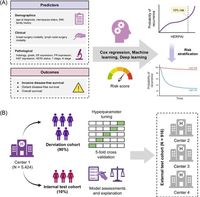A new prognostic model, named HERPAI, has emerged as a groundbreaking approach to predicting recurrence risk among patients with early-stage hormone receptor-positive, human epidermal growth factor receptor-negative (HR+/HER2−) breast cancer. Developed using data from four independent medical centers and based on deep learning techniques, HERPAI aims to enhance treatment decisions, specifically for women diagnosed with early-stage invasive breast cancer who may have previously faced uncertainties regarding their risk of recurrence.
Breast cancer remains one of the most prevalent malignancies among women globally, with the HR+/HER2− subtype accounting for a significant majority of cases. Although the introduction of adjuvant endocrine therapy has improved outcomes, the rate of distant recurrence remains higher than 10% over 20 years even for early-stage patients. The need for a more robust predictive tool is evident, especially given that existing models often lack applicability for earlier stages of the disease.
Following a retrospective analysis including 6,340 patients—from January 2012 to December 2023—researchers from various institutions sought to refine the understanding of recurrence risks in this specific patient population. The patients were divided into a derivation cohort consisting of 5,424 individuals and an external validation cohort with 916 patients. The HERPAI model, honed using a Transformer deep learning structure, demonstrated promising capabilities in estimating invasive disease-free survival (iDFS) rates.
The model's assessment yielded a C-index, which measures the model's accuracy, of 0.73 across both the validation and internal test cohorts, as well as 0.68 in the external validation cohort. This indicates a strong ability to distinguish between patients at differing levels of recurrence risk. Moreover, high-risk patients identified by HERPAI showed a significant association with increased recurrence rates, with data revealing a hazard ratio (HR) of 2.56 for the validation cohort. These findings underscore the potential of HERPAI to facilitate the prioritization of patients who could benefit from more aggressive treatments.
As described in the study published in Scientific Reports, the authors noted, “HERPAI was a promising tool for selecting vulnerable early-stage HR+/HER2− BC patients who were at high-risk of recurrence.” This statement signifies the capacity of HERPAI to redefine how clinicians approach treatment planning for patients who may have previously been viewed as low-risk—a crucial development given the challenges faced in this subtype of breast cancer.
The methodology involved collecting various clinical and pathological predictors, and the outcome definitions were centered around invasive disease-free survival, which encompasses local and regional recurrence—a key metric for understanding overall tumor behavior. The authors outlined the importance of refining predictive models to help medical professionals decide on treatment regimens, particularly in optimizing the use of adjuvant therapies in patients likely to benefit most.
In a robust follow-up period, the study revealed that approximately 25% of participants had been reclassified as high-risk under the HERPAI model, complicating previous assumptions regarding their recurrence profiles. Specifically, the validation cohort showed that the hazard ratios highlighted a stark increase in the likelihood of disease recurrence among high versus low-risk groups, contributing to awareness about the need for tailored therapeutic strategies.
Interestingly, HERPAI’s predictive capabilities outperformed established models, including the Cox regression and XGBoost methods, which often relied on traditional statistical approaches. “Reliable performance was observed for HERPAI in both internal and external test cohorts,” the authors stated, emphasizing the model's superior ability to handle complex predictor interactions that are common in clinical scenarios.
The research underlined the necessity for ongoing validation of HERPAI in larger, prospective cohorts to confirm its viability as a decision-making tool. The collaborative nature of the study—which utilized data from four separate medical institutions—adds to the credibility of the findings, particularly since the utilization of deep learning represents a shift towards more sophisticated computational frameworks in risk assessment.
In conclusion, HERPAI represents an essential advancement in understanding breast cancer recurrence risk, leveraging deep learning capabilities to enhance prognosis for early-stage HR+/HER2− breast cancer patients. The authors of the research highlight the urgency in further validating this tool within the clinical realm, calling for additional studies that encourage personalized treatment approaches aimed at improving patient outcomes in this prevalent cancer subtype.
By utilizing HERPAI, healthcare providers can engage in more informed discussions regarding treatment options, ensuring that they can effectively address patient-specific needs within the evolving landscape of breast cancer management.

